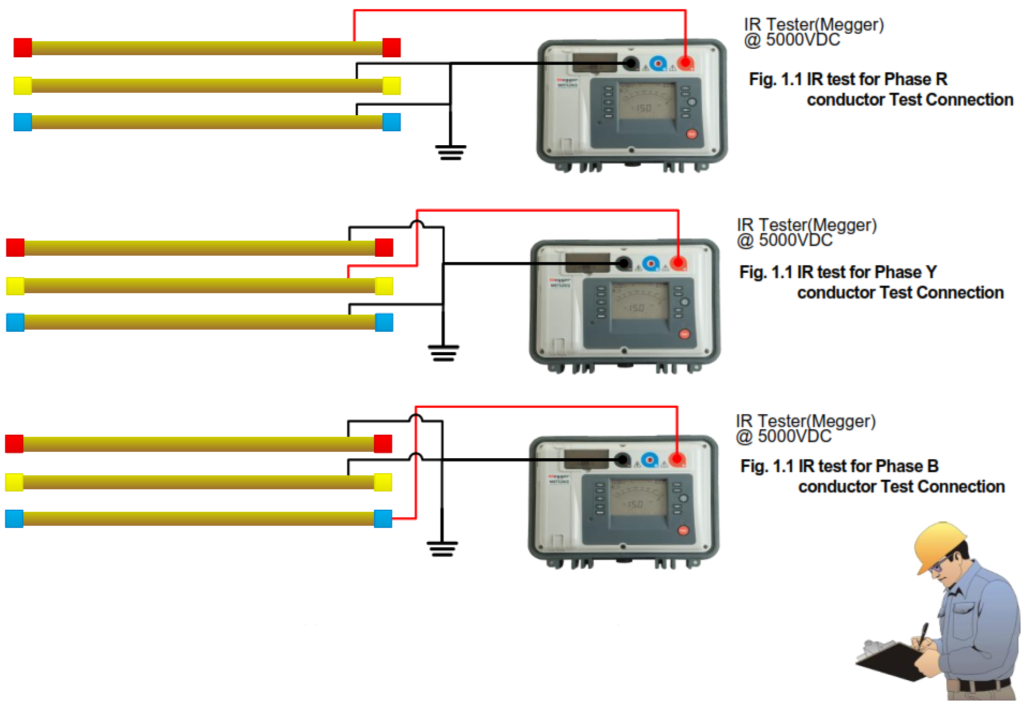Testing a 13.8kV switchgear busbar switch is a crucial step to ensure the reliability and safety of the electrical distribution system. Below is a general test procedure for a 13.8kV switchgear busbar switch. Please note that specific procedures may vary based on the manufacturer’s guidelines and equipment specifications. Always refer to the manufacturer’s documentation for the most accurate and detailed information.
This article is about to guide the responsible persons like electrical engineers, technicians and supervisors in conducting 13.8kV Switchgear Busbar Switch Tests.
SAFETY PRECAUTIONS – The following Safety precautions shall be taken in consideration prior, during and after conducting the test measurements.
- Safety tagging shall be implemented.
- Isolate the Area by Safety Warning Tape.
- Keep a Safe Distance from the device being tested.
- Wear Appropriate Personal Protective Equipment(PPE) Prior to starting any testing activity.
- Implementation of Proper Grounding.

13.8kV Switchgear Busbar Switch Test Procedure
TEST EQUIPMENTS: Megger IR test Kit
- Phase Checking for Busbar
1.1 1kV DC Test Voltage is applied by connecting the megger terminals at one end as shown in the figure below. The other end is grounded through a switch and the resistance is measured by closing the switch.

1.2 Repeat the above test steps for phase Y(with Phase R and B open) and Phase B (with Phase Y and B open).
1.3 Record the measured Resistance in applicable test forms. which should equal to zero to indicate both ends belong to the same phase.
- Insulation Resistance Measurement
2.2 Conduct testing as per below connection diagram with applied voltage of 5kV DC from the IR/Capacitance Tester for a
duration of 1 minute.

2.2 Record the measured IR values in applicable test forms and evaluate as per standards/set criteria (>100 MΩ).
General Instructions for Test:
- Visual Inspection:
- Inspect the switchgear and busbar switch for any visible signs of damage or wear.
- Check for loose connections, corrosion, or overheating.
- Verify that the switchgear is properly grounded.
- Insulation Resistance Test:
- Measure the insulation resistance between phases and between each phase and ground using an insulation resistance tester.
- Ensure that insulation resistance values meet or exceed specified limits.
- Contact Resistance Test:
- Perform a contact resistance test using a contact resistance tester.
- Measure the resistance of each main and auxiliary contact.
- Compare the measured values with the manufacturer’s specifications.
- Control Circuit Test:
- Verify the functionality of the control circuits by simulating various operating conditions using a secondary injection test set.
- Check the operation of interlocks and alarms.
- High-Potential (Hi-Pot) Test:
- Perform a high-potential test using a megger test set to ensure the integrity of the insulation.
- Follow the manufacturer’s guidelines for the test voltage and duration.
- Functional Test:
- Energize the switchgear and conduct a series of tests to ensure the busbar switch operates correctly.
- Verify the opening and closing sequences, and check for any abnormal noises or vibrations.
- Thermal Imaging:
- Use a thermal imaging camera to identify any hotspots or abnormalities in the switchgear and busbar switch.
- Pay special attention to connections and busbars.
- Documentation:
- Record all test results, including measurements and observations.
- Compare the results with the manufacturer’s specifications.
- Document any deviations or issues encountered during testing.
- De-Energization:
- Safely de-energize the switchgear and busbar switch.
- Restore any safety devices or barriers that were removed for testing.
- Report:
- Prepare a comprehensive test report summarizing the procedures, results, and any recommended actions.
- Include any deviations from specifications and actions taken to address them.
Always follow safety guidelines and manufacturer’s instructions during the testing process. If you are not familiar with the testing procedures or if there are any doubts, consult with qualified personnel or the equipment manufacturer.